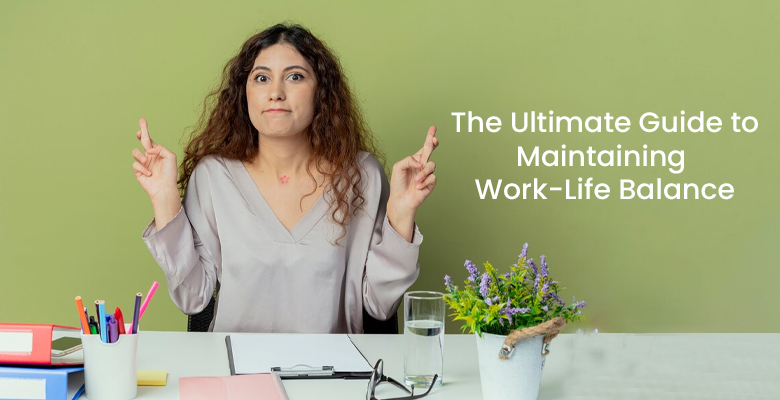
Understanding Work-Life Balance
Work-life balance is the equilibrium between work and personal life. It means focusing on creating a healthy boundary where one’s work does not dominate life but instead compliments it. Maintaining work-life balance is helpful if you want to foster productivity and fulfill a lifestyle.
Achieving this balance is not just crucial for mental health but also for overall health and productivity. According to a survey by the American Psychological Association, 40% of employees report their jobs as very or extremely stressful. This, in turn, highlights a need for effective balance strategies. Moreover, a Gallup report stated that 23% of employees feel burned out at work very often or almost all the time, while an additional 44% of employees feel burned out sometimes.
Tips to Maintain a Work-Life Balance
Prioritize Time Management
The cornerstone of a perfect work-life balance is effective time management. You can consider organizing your tasks and setting realistic deadlines. This way neither your work nor your personal life suffers. Multiple tools can be used for time management like calendars, planners, and project management apps.
Research from the University of California Irvine indicates that it takes an average of 23 minutes to regain focus after a distraction which makes time management even more crucial. So, for maintaining work-life balance prioritizing time management is important.
Actionable steps
- Daily Planning- Make a to-do list every day before you start working. Assign each task a priority level and then complete them accordingly.
- Prioritization- Focus on urgent and important tasks first
- Delegation- Assign tasks that can be handled by others
Set Boundaries
One should create clear boundaries between work and personal time. This does not just prevent burnout but also increases productivity. You need to stick to your shift timings even if you work remotely. A study by the International Journal of Environmental Research and Public Health found that clear boundary management significantly reduces work-life conflict and enhances well-being.
Actionable Steps
- Office Hours- Define and adhere to a strict work schedule
- Designated workspace- Create a dedicated work area at home
- Technological use- Avoid or limit after-hours work communications. You can also consider turning off work-related notifications outside of work hours
Take Regular Breaks
To improve your productivity and reduce stress, you should take regular breaks from work. According to the Pomodoro technique, 25 minutes of focused work should be followed by a 5-minute break. It is one of the best ways to maintain a healthy work-life balance. Regular breaks are key to maintaining high performance.
Actionable Steps
- Short Breaks- Take 5–10-minute break after every hour
- Lunch Break- Ensure a substantial break for meals, ideally away from the workspace.
- Physical activity- Incorporate short walks or stretches during breaks.
Foster Hobbies and Interests
While hard work is the key to success, however, engaging in hobbies and activities outside work rejuvenates the mind and body. Employees who engage in creative activities outside of work report higher job performance and a greater ability to recover from stress. So, if you indulge in some playful and stress-relieving activities outside of work, it can increase your productivity substantially.
Actionable Steps
- Scheduled Time- Consider allocating specific times for hobbies during the week.
- Social Connections- You can join clubs and groups that share your interests.
- New Skills- If you think you have time for a new hobby or a new skill, it can be beneficial to keep your mind engaged.
Practice Mindfulness and Relaxation
To improve focus, you can consider practicing mindfulness and relaxation techniques. It includes meditation, yoga, deep breathing, and more. A study by the American Psychological Association found that 40% of people who meditate report feeling less stressed at work. Additionally, the National Institute for Occupational Safety and Health reports that stress management programs can reduce workplace stress by up to 20%. Mindfulness is the key to maintaining work-life balance. Make sure to minimize your screen time after work and indulge in different activities, give time to your family and friends, or just take that time for yourself.
Actionable Steps
- Daily meditation- Spend 10-15 minutes meditating each day
- Yoga- Integrate Yoga sessions into your weekly routine
- Deep Breathing- Practice deep breathing exercises during stressful moments.
Seek Support
The last point to maintain a work-life balance is to seek support if you feel you need it. Taking to family, friends, or professional counselors can provide a solid foundation for managing stress and maintaining a balance in life. A study by the Society for Human Resource Management found that 76% of employees who receive emotional support from colleagues feel more satisfied at work.
Actionable Steps
- Open Communication- Talk about your challenges with trusted friends or family.
- Professional Help- Don’t hesitate to seek help from a counselor or therapist.
- Support Groups- Join groups where you can share experiences and strategies.
Achieving more balance in the lives of healthier and more productive people is feasible if they follow through with the following 6 strategies. This is something you have to keep doing and keep adjusting.
Balance work and personal life is about taking care of time management, setting boundaries, taking regular breaks, having hobbies practicing mindfulness, and looking for help. Remember that finding balance has nothing to do with perfection but it requires deliberate decisions aimed at enhancing one’s general health.
